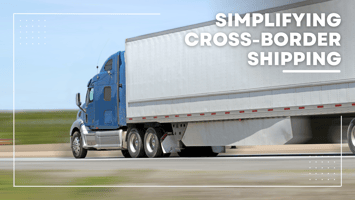Canada and the United States share a long history of mutually beneficial trade. Each day thousands...
A Guide For Importing To Canada: Tips & Resources
Canada’s foreign trade is one of the largest in the world. When you're importing to Canada, there are a lot of things happening behind the scenes that may not seem quite so seamless. There are many rules and regulations which need to be followed properly, so that commercial goods can cross the border. Handling Canadian customs can be daunting, but it doesn't have to be. Knowing the rules and guidelines can help you avoid unnecessary hassles, fines, or delays.
.png?width=1280&height=720&name=Orange%20Modern%20Minimal%20Blog%20Writing%20YouTube%20Thumbnail%20(4).png) Customs is the act of regulating trade. For businesses of any size, we recommend that you research what your responsibilities are, and make sure you meet these requirements in order to import products into Canada. However, if you are transporting or shipping into Canada, there are a few tips which can help make the process quicker and easier.
Customs is the act of regulating trade. For businesses of any size, we recommend that you research what your responsibilities are, and make sure you meet these requirements in order to import products into Canada. However, if you are transporting or shipping into Canada, there are a few tips which can help make the process quicker and easier.
Understand Which Agency You Are Dealing With
Any shipments coming into Canada will be reviewed by the Canada Border Services Agency (CBSA). The agency is responsible for reviewing anything entering the country, as a way to ensure security. The CBSA also partners with other government agencies to determine regulations and rules which will guide shipments into and out of the country. Any shipment coming in has to adhere to CBSA specific guidelines, which are subject to change at times. In order to stay up to date on regulations you can view the CBSA website here, or you can contact a customs broker to help you navigate the shipping process a little more easily.
Prepare a Canada Customs Invoice
A critical component to any shipment will be the Canada Customs Invoice (CCI), as it contains important information about the shipment, consignee and vendor. Shipments which are missing a Canada customs invoice will be delayed and the goods will not be able to cross. It is essential that the invoice and all your paperwork is accurate, in the case of any audits, so you will want to have a complete record of accurate documents to follow. It is essential to complete all the mandatory parts of the invoice form, including information on:
- Country of Origin
- Currency
- Quantity and Weight
- Value of Shipment
- Purchaser Record
- Date of the Shipment
In order to simplify the process, and complete an invoice correctly the first time, you can use the Zipments.io Canada Customs Invoice form generator. You simply fill in the form fields, and the system will automatically use AI technology to generate relevant tariff codes and ensure accuracy of your invoice, within minutes.
Hire the Right Customs Broker
When shipping to another country, you will want a broker on the side of the border the goods are heading to, in order to clear everything with customs as easily as possible. You want to vet all brokers and ensure the broker you deal with can handle your freight volume and needs. The broker is going to know the latest up to date regulations, as well as which documents are needed to complete the transport journey across the border. The broker is responsible for submitting your paperwork and dealing with customs in the case any questions or additional needs come up. Every broker should be communicating with the client and carrier regularly, in order to streamline and improve the process.
Familiarize Yourself With Canadian Duties and Taxes
Any goods coming into Canada are subject to duties, fees or taxes in accordance to the nations’ regulations. Before shipping, it is important to get an estimate or understanding of how much these fees will be for a specific shipment, so that there are no surprises at the border. The duties calculated will be dependent on where the item is coming from, as well as the tariff classification or HS code for the goods.
You can use the Canada Duties and Taxes Calculator on Zipments.io to instantly get an accurate estimate of the amount that you will likely need to pay for that specific shipment, including import fees. You will simply input what is being imported, including the value and product category, which allows for an accurate estimate of the amount owed to be calculated for you, so you can prepare ahead of time and know what to expect.
In order for goods to be released at the border, paperwork has to be approved and duties must be paid first. You may pay duties usually through cash or cheque, but it is important to inquire on this matter or ask in advance so that you are prepared. If you are working with a customs broker, then they would help take care of this step for you.
Compile All Necessary Documents
It is not enough to know what the regulations for Canadian imports are, it is imperative that all shipments have the adequate documents to accompany them. Without the documentation, it is likely that delays and even fines may occur. In order to transport goods into Canada you will need, at the least, the following documents:
- Packing List
- Canada Customs Invoice
- Bill of Lading
- Certificate of Origin
- Cover Sheet
- Canadian Carrier Code
Communicate With Carriers and Prepare Them
Any carriers or drivers transporting goods into Canada will need to be prepared ahead of time and supplied the right documents, so that they are not delayed. A PARS sticker or label is essential when it comes to crossing into Canada. The PARS label is a sticker compromised of the carrier code and unique shipment number, and you may sometimes hear it referenced along with Cargo Control Number (CCN). This label identifies the carrier and shipper to CBSA and will be important in clearing customs in Canada.
Communication between customs broker and carrier needs to be clear. Carriers need to inform brokers ahead of time of the port of crossing, their contact information and estimated arrival date/time. Brokers also should be able to provide carriers with contact information in case something goes wrong. Carriers can easily access broker contact information using the Zipments Customs Broker Directory, so you never again end up stranded at the border with no one to call.
Get Familiar With The ACI eManifest
In order to cross into Canada, there is a need to submit the pre-arrival data and documents to customs ahead of time. Canada uses the ACI eManfiest, which is essential to be able to clear customs. It is not enough to send information to a broker and expect them to set up PARS for clearance, unless the broker is also an eManifest service provider. This is an important step to double check ahead of time, and verify that the eManifest is filed.
Research Labeling Regulations
Canadian customs can be strict with not only the documents of the shipment entering, but also the labeling rules surrounding the goods. Different products will need to follow specific laws, such as how to express net quantity of a product, and a products place of manufacturing label guidelines. For one, The Canadian Consumer Packaging and Labeling Act requires that all labels for goods sold in Canada be in both English and French. If the goods you are shipping require any warning labels, then they need to be accurate and in compliance with laws, otherwise there could be penalties resulting. You can research up to date labeling regulations in Canada on the government website:
Canadian Labeling Requirements
When importing goods into Canada, you could be facing a number of factors. It's important to know what each one entails and how to deal with customs properly. The best way to navigate the Canadian border is with careful planning, the right platform and partners. Customs can be tricky, but know that you’ve got the tools to make each trip a success!




.jpg?height=200&name=Business%20Network%20Presentation%20Templates%20(1).jpg)
